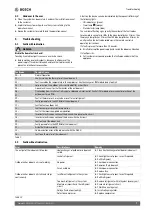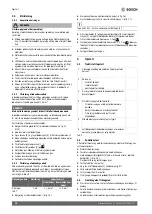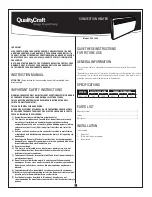
Commissioning
Climate 6100i/8100i – 6721821567 (2020/11)
6
▶ Open valve at bottom [2] (gas side).
The refrigerant is distributed round the system.
▶ Afterwards, check the pressure ratios.
▶ Unscrew the Schrader opener [6] and close the Schrader valve [1].
▶ Remove the vacuum pump, pressure gauge and Schrader opener.
▶ Reattach the valve caps.
▶ Reattach the cover for pipe connections to the outdoor unit.
3.5
Electrical connection
3.5.1
General notes
WARNING
Risk to life from electric shock!
Touching live electrical parts can cause an electric shock.
▶ Before working on electrical parts, disconnect all phases of the
power supply (fuse/circuit breaker) and lock the isolator switch to
prevent unintentional reconnection.
▶ Work on the electrical system must only be carried out by a qualified
electrician.
▶ Observe safety measures according to national and international
regulations.
▶ If there is a safety issue with the power supply or if there is a short
circuit during installation, inform the customer in written form and do
not install the unit until the issue is resolved.
▶ All electrical connections must be made in accordance with the
electrical connection diagram.
▶ Only strip cable insulation with the correct tools.
▶ Do not connect any additional loads to the mains power supply of the
device.
▶ Do not mix up live and neutral wires. This can lead to malfunctions.
▶ If the mains power supply is fixed, install an overvoltage protector
and isolator which is designed for 1.5 times the maximum power
consumption of the device.
3.5.2
Connect the indoor unit
The indoor unit is connected to the outdoor unit using a 4-wire
communication cable of the type H07RN-F. The conductor cross-section
of the communication cable should be at least 1.5 mm
2
.
NOTICE
Material damage due to incorrectly connected indoor unit
Voltage is supplied to the indoor unit via the outdoor unit.
▶ Only connect the indoor unit to the outdoor unit.
To connect the communication cable:
▶ Process the end of the connecting lead [3] for the indoor unit
(
▶ Fold up the top cover.
▶ Remove screw [4] and cover [5] of the terminal.
▶ Knock out an opening for the cable feed on the rear of the indoor unit
and feed the cable through.
▶ Connect the cable to terminal N, 1, 2.
▶ Connect protective conductor [2] to
.
▶ Note assignment of wires to the terminals.
▶ Reattach the cover of the switch on terminal.
▶ Close the top panel.
▶ Route the cable to the outdoor unit.
3.5.3
Connecting the outdoor unit
A power cable (3-wire) is connected to the outdoor unit and the
communication cable is connected to the indoor unit (4-wire). Use
cables of the type H07RN-F with sufficient conductor cross-section and
protect the mains power supply with a fuse (
Table 7).
Table 7
▶ Prepare the end of the power cable (
Fig. 15).
▶ Prepare the end of the communication cable (
Fig. 16).
▶ Remove the covers [3+6] of the electrical connection (
Fig. 17).
Model CL6100i ... only has the cover [3].
▶ Secure power cable [2] and communication cable [1] to the strain
relief [4]. If necessary, insert the supplied inlay [5] in-between.
▶ Secure power cable to terminals N, 1, and
.
▶ Secure the communication cable to terminals N, 1, 2 and
(assignment of wires to terminals same as indoor unit).
▶ Reattach the covers.
4
Commissioning
4.1
Commissioning checklist
Table 8
4.2
Functional test of device
The system can be tested once the installation including tightness test
has been carried out and the electrical connection has been established:
▶ Connect the power supply.
▶ Switch on indoor unit with the remote control.
▶ Keep the key for auxiliary mode [1] pressed for 5 seconds to set the
cooling mode (
Fig. 18)
A beep sounds and the ON indicator flashes.
▶ Test cooling mode for 5 minutes.
▶ Ensure freedom of movement of air baffle [2].
▶ Select the heating mode on the remote control.
▶ Test heating mode for 5 minutes.
▶ Press the auxiliary mode button again to stop the operation.
Outdoor unit
Mains fuse
protection
Conductor cross-section
Power cable
Communication
cable
All types
16 A
≥ 1.5 mm
2
≥ 1.5 mm
2
1
Outdoor unit and indoor unit are correctly installed.
2
Pipes are correctly
• connected,
• thermally insulated,
• and checked for tightness.
3
Condensate pipes are functioning correctly and
have been tested.
4
Electrical connection has been correctly
established.
• Power supply is in the normal range
• Protective conductor is properly attached
• Connection cable is securely attached to the
terminal strip
5
All covers are fitted and secured.
6
The horizontal louver of the indoor unit is fitted
correctly and the actuator is engaged.







































